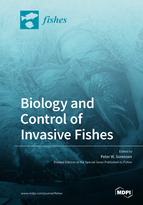Geographic-Scale Harvest Program to Promote Invasivorism of Bigheaded Carps
Round 1
Reviewer 1 Report
This paper provide an important look at the use and potential control of invasive fishes such as the bigheaded carp in rivers of Illinois.
Much of the manuscript is well written and very clear. However, there are several things that need to be addressed to improve the manuscript that include minor edits and some beefing up of the methods section.
pp. 3-5 in section 2 " Conceptiual Model" please add methods that were used in section 3 "Results" sub-sections 3.2,3.3, and 3.4 in order for the reader to fairly evaluate the meaning of the results presented.
subsection 3.4 justify paragraph and adjust font to match rest of paper
the discussion seems to be appropriate for the data presented however the data is nearly a decade old at this point and the harvest has continued in thee fisheries based upon the Asian carp Action plan of 2020. If additional longitudinal data were available it would strengthen the paper in light of the delayed publication.
Author Response
Please see attachment.
Author Response File: ![]() Author Response.pdf
Author Response.pdf
Reviewer 2 Report
In this paper a conceptual model was developed and evaluated harvest approaches including direct contracted removal, volume-based incentives for direct-consumption markets (“fisher side” control), and set-quota harvest for indirect-consumption markets (“market side” control). Authors quantified the efficacy of these approaches and potential population impact in the Illinois River.
The paper brings about an interesting topic, however, its structure can be improved.
Suggestion is that in the Introduction (part 1) authors state the main aim of the paper and the main hypothesis. After the conceptual model and before the results authors should explain the methodology (insert part 5 as part 3 of the paper). Paper is missing a clear conclusion. Part of discussion (part 4) can serve as a conclusion, as discussion usually serves for discussing the results and comparing them with other research. In the conclusion, main points should be summarized, limitations of the study should be pointed out as well as practical/scientific implications of the study.
Author Response
Please see attachment.
Author Response File: ![]() Author Response.pdf
Author Response.pdf
Reviewer 3 Report
I have provided my comments in the attached document. In addition to what i wrote, there is no conclusion in this paper. I am wondering why.
Comments for author File: ![]() Comments.pdf
Comments.pdf
Author Response
Pleas see attachment.
Author Response File: ![]() Author Response.pdf
Author Response.pdf
Reviewer 4 Report
It is an interesting paper. Perhaps a final scheme may help the reader to compare the different approaches.
The paper is structured into 5 paragraphs (introduction included). It is a detailed story of the Invasive bigheaded carps that are expanding their range throughout the Mississippi River basin.
It is not an analytical but an exploratory discursive paper. However, it is interesting because it exposes the problem of invasivorism in detail even if in some parts it is not easy to read. For this reason, I believe that it is useful to include a final summary scheme in the book.
Author Response
Please see attachment.
Author Response File: ![]() Author Response.pdf
Author Response.pdf
Round 2
Reviewer 1 Report
Comments adequately addressed. This is a good paper with needed information to contextualize the management issues of Bigheaded carp in the Mississippi River Basin.
Reviewer 3 Report
Thank you for working on suggested comments.




